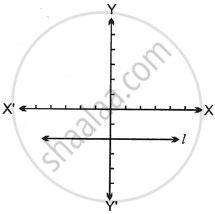Advertisements
Advertisements
प्रश्न
Prove that A(4, 3), B(6, 4), C(5, 6) and D(3, 5) are the angular points of a square.
उत्तर
Now
AB = `sqrt((4 - 6)^2 + (3 - 4)^2)`
= `sqrt(4 + 1) = sqrt(5)"units"`
BC = `sqrt((6 - 5)^2 + (4 - 6)^2) = sqrt(1 + 4)`
BC = `sqrt(5)"units"`.
CD = `sqrt((5 - 3)^2 + (6 - 5)^2) = sqrt(4 + 1)`
CD = `sqrt(5)"units"`
Also DA = `sqrt((4 - 3)^2 + (3 + 5)^2)`
= `sqrt(1 + 4) = sqrt(5)`
DA = `sqrt(5)"units"`
So AB = BC = CD = DA.
Now slope of AB = m1 - `(4 - 3)/(6 - 4) = (1)/(2)`
Slope of BC = m2 = `(6 - 4)/(5 - 6) = (2)/(-1)`
Slope of CA = m3 = `(5 - 6)/(3 - 5) = (1)/(2)`
Slope of DA = m4 = `(5 - 3)/(3 - 4) = (2)/(-1)`
Since m1 = m3 and = m2 = m4
So AB || CD
and BC || DA.
Therefore, AB ⊥ BC
∴ ABCD is a square.
Hence proved.
APPEARS IN
संबंधित प्रश्न
A(5, 4), B(−3, −2) and C(1, −8) are the vertices of a triangle ABC. Find:
- the slope of the altitude of AB,
- the slope of the median AD and
- the slope of the line parallel to AC.
Find the slope of the line which is perpendicular to `x - y/2 + 3 = 0`
Angle made by the line with the positive direction of X-axis is given. Find the slope of the line.
45°
Fill in the blank using correct alternative.
Distance of point (–3, 4) from the origin is ______.
Determine whether the given point is collinear.
A (0, 2), B (1, -0.5), C (2, -3)
Show that A(4, –1), B(6, 0), C(7, –2) and D(5, –3) are vertices of a square.
Write the equation of a line passing through the point P (0,6) and having slope 6/7.
If the lines 7y = ax + 4 and 2y = 3 − x, are parallel to each other, then the value of ‘a’ is:
In the figure, line l is parallel to X-axis. Which of the following statement is true?

What is the name of the point of intersection of coordinate axes?
